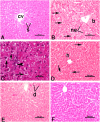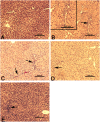Free Radical-Scavenging, Anti-Inflammatory/Anti-Fibrotic and Hepatoprotective Actions of Taurine and Silymarin against CCl4 Induced Rat Liver Damage
- PMID: 26659465
- PMCID: PMC4676695
- DOI: 10.1371/journal.pone.0144509
Free Radical-Scavenging, Anti-Inflammatory/Anti-Fibrotic and Hepatoprotective Actions of Taurine and Silymarin against CCl4 Induced Rat Liver Damage
Abstract
The present study aims to investigate the hepatoprotective effect of taurine (TAU) alone or in combination with silymarin (SIL) on CCl4-induced liver damage. Twenty five male rats were randomized into 5 groups: normal control (vehicle treated), toxin control (CCl4 treated), CCl4+TAU, CCl4+SIL and CCl4+TAU+SIL. CCl4 provoked significant increases in the levels of hepatic TBARS, NO and NOS compared to control group, but the levels of endogenous antioxidants such as SOD, GPx, GR, GST and GSH were significantly decreased. Serum pro-inflammatory and fibrogenic cytokines including TNF-α, TGF-β1, IL-6, leptin and resistin were increased while the anti-inflammatory (adiponectin) cytokine was decreased in all treated rats. Our results also showed that CCl4 induced an increase in liver injury parameters like serum ALT, AST, ALP, GGT and bilirubin. In addition, a significant increase in liver tissue hydroxyproline (a major component of collagen) was detected in rats exposed to CCl4. Moreover, the concentrations of serum TG, TC, HDL-C, LDL-C, VLDL-C and FFA were significantly increased by CCl4. Both TAU and SIL (i.e., antioxidants) post-treatments were effectively able to relieve most of the above mentioned imbalances. However, the combination therapy was more effective than single applications in reducing TBARS levels, NO production, hydroxyproline content in fibrotic liver and the activity of serum GGT. Combined treatment (but not TAU- or SIL-alone) was also able to effectively prevent CCl4-induced decrease in adiponectin serum levels. Of note, the combined post-treatment with TAU+SIL (but not monotherapy) normalized serum FFA in CCl4-treated rats. The biochemical results were confirmed by histological and ultrastructural changes as compared to CCl4-poisoned rats. Therefore, on the basis of our work, TAU may be used in combination with SIL as an additional adjunct therapy to cure liver diseases such as fibrosis, cirrhosis and viral hepatitis.
Conflict of interest statement
Figures




References
Publication types
MeSH terms
Substances
LinkOut - more resources
Full Text Sources
Other Literature Sources
Medical
Research Materials
Miscellaneous

